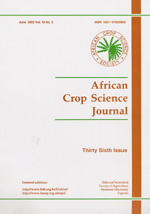
|
African Crop Science Journal
African Crop Science Society
ISSN: 1021-9730
EISSN: 1021-9730
Vol. 8, No. 3, 2000, pp. 203-211
|
 Bioline Code: cs00022
Bioline Code: cs00022
Full paper language: English
Document type: Research Article
Document available free of charge
|
|
|
African Crop Science Journal, Vol. 8, No. 3, 2000, pp. 203-211
| en |
Inheritance of Resistance to Pod Shattering in Soybean
Tukamuhabwa, P.; Rubaihayo, P.R.; Dashiell, K. & Adipala, E.
Abstract
Hybridisation of soybean between susceptible varieties AGS 292 and TGm 737P, and resistant varieties, Duiker, Gc81090-48, Roan and TGx 1448-2E, and intermediate varieties, Kabanyolo 1 and Samsoy 1 , were carried out and the pods assessed for shattering using an oven set at 80 °C for 12 hours. The phenotype of F1 populations was closer to the susceptible parents and the distribution of F2 populations was not descrete and could not fit Mendelian ratios. Based on a 1 - 3 scale, the distribution best fitted the 1:3:12 genetic model suggesting genetic control by classical dominant epistasis. The parent offspring regression, suggested a heritability estimate in the narrow sense of 0.79. The average number of segregating genes were 2.01 and 2.06 for F2 and F3 respective generations in six crosses, suggesting that the shattering trait in soybean is conditioned by 2 genes.
Keywords
Epistasis, gene number, Glycine max, heritability, progenies
|
| |
| fr |
Tukamuhabwa, P.; Rubaihayo, P.R.; Dashiell, K. & Adipala, E.
Résumé
Le croisement du soja entre les variétés susceptibles AGS292 et TGm737P, et les variétés résistantes, Duiker, Roan et TG x 1448-2E, et des intermediares, Kabanyolo1 et Samsoy1, a été faite et des gousses ont été évaluées pour léclatement en utulisant la méthode détuve fixée à 80 °C pendant 12 heures. Le phenotype de la population F1 était presque semblable à celui des parents susceptibles et la distribution de la population F2 nétait pas discrète et ne correspondait pas au rapport Mandelien. Basé sur une échelle de 1 à 3, la distribution repondait au modèle génétique 1:3:2 suggérant un controle génétique d épistasie classique dominante. La régression des descendants des parents a suggéré une héritabilité au petit sens de 0.79. Le nombre moyen des gènes ségrégant était 2.01 et 2.06 pour les progénitures F2 et F3 respectivement dans les six croisements, suggérant que le caractère éclatement chez le soja est controlé par deux gènes.
Mots Clés
Epistasie, nombre de gènes, Glycine max, héritablité, progénitures
|
| |
© Copyright 2000 - African Crop Science Society
|
|
